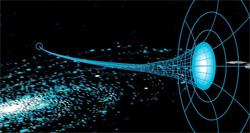 This is the fourth in my series on various flavors of Faster Than Light (FTL) travel, and today I’m dropping into wormholes. The basic idea of a wormhole is that it’s a shortcut between two points. Usually they are fixed points, but there’s some variation on that. Sometimes they are done as predefined shortcuts through some alternate parallel space, and other times they are special tunnels through our own space.
This is the fourth in my series on various flavors of Faster Than Light (FTL) travel, and today I’m dropping into wormholes. The basic idea of a wormhole is that it’s a shortcut between two points. Usually they are fixed points, but there’s some variation on that. Sometimes they are done as predefined shortcuts through some alternate parallel space, and other times they are special tunnels through our own space.
In most cases, they are fairly permanent and independent of the ships traversing them. Thus, ships that have only sublight capabilities are now about to cross vast interstellar distances just by popping through these wormholes, just like a pedestrian can cross town quickly by taking the subway.
FTL-to-FTL interactions: These are almost nonexistent. The only interactions you might have are with other ships (or beings) that are in the same wormhole with you. Plus, wormhole trips are usually presented as being fairly short, so the opportunities for interaction would be fleeting.
FTL-to-sublight interactions: There are none. At least, that’s how I typically see it done. The wormhole is completely cut off from the rest of the universe. At best, there might be some communication with stations near either end of the wormhole.
Relativistic effects: Typically, there are none. Sometimes the transits are essentially instant, like walking through a doorway. Other times, they last seconds to hours, but it’s generally presented as time flowing tick by tick along with a stationary timeframe.
However, I know of one wormhole setup where the wormhole is a tubular region of space where time flows thousands of times faster than normal, thus making the speed of light in that region thousands of times faster. Ships passing through this make up for the time-scale by travelling at relativistic speeds, thus slowing their internal time by a similar factor to the external speed increase. Thus, they make a multi-year journey in a few minutes according to their own clocks and quite possibly a few minutes according to our clocks as well. In that setup, however, there is no guarantee of an absolute matchup between the ship clocks and the stationary clocks, so there would be some variation from one wormhole to another, and sometimes even from one trip to another on the same wormhole.
In-FTL Navigation: Nope, sorry. You don’t get to steer the train. You can’t even pull the emergency brake. And no hopping out the back either. You stay on it until it dumps you out the other end. Do not pass Rigel. Do not collect two hundred quatloos. Your best bet is to hope that there are other wormholes near the end of this one so that you can exercise at least a little choice.
Speed Differential: In all the wormhole systems I’ve seen, the ships within the wormhole all travelled through it at the same speed. Or if there was any speed variation, it was not under the control of the ships themselves. They were merely being swept along by currents of different speed. Of course, there’s no guarantee that all wormholes move you along at the same speed.
Malfunctions: All the breakdowns I’ve seen with wormholes have been with the wormholes themselves. Either they collapsed or became untethered at one end. Typically, the worst that happens to you is that you’re stuck at the wrong end of a wormhole. Then again, I’d hate to be inside one when it collapsed.
Special traits: Wormholes have several interesting traits in the story-telling sense. The first is that they are often pre-existing objects outside the control of the characters using them. Maybe they’re naturally occurring phenomena, or maybe they were built by “the ancients”. Or maybe, like the subways, they were built by the government, and we peons have to live with them as they are. They key here is that it’s no longer a space travel system where we get to pick out our destination and sail on through the night. Instead, there are a handful of destinations to pick from, and if that’s not where we want to go, that’s just too bad.
The second interesting thing about wormholes is what they do to the Euclidean topology of space. I’m not referring to some freaky space warping around the wormhole entrance. Rather, I mean that Rigel is now 500 million kilometers away rather than 900 light years, because there’s a wormhole to take us there. Meanwhile, our next door neighbor Proxima is still 4.24 light years away because it has no wormhole. Yet another nearby star Sirius is now only 2.1 billion kilometers away (rather than 8.6 light years) because we can get to it via a series of wormholes, i.e. first Rigel, then to Polaris, Antares, Deneb, and finally Sirius. (Don’t get lost at Deneb – it’s a bad neighborhood.)
And finally, if the wormholes are not strictly ignorant carriers of traffic, but instead, intelligent agents of control, then those first two factors can make for some very interesting situations. Imagine being able to control all commerce, traffic, even information flow between these distant stellar islands, simply by deciding which ships will complete their journey, which worlds to cut off, or which radio transmissions to shunt aside. Now start thinking about it from the point of view of we peons not realizing that the wormholes are under intelligent control, and let your space-opera paranoia turn all the way up to Eleven.
 But one last bit on wormholes. Like the warp drive, these might be possible if not actually feasible. What we call a wormhole is remarkably similar to a prediction of General Relativity, known more properly as a Einstein-Rosen Bridge. However, since our best theoretical examples of such wormholes are tied up with black holes, this still has a long way to go to before we can turn it into the green-line express from Sol to Rigel.
But one last bit on wormholes. Like the warp drive, these might be possible if not actually feasible. What we call a wormhole is remarkably similar to a prediction of General Relativity, known more properly as a Einstein-Rosen Bridge. However, since our best theoretical examples of such wormholes are tied up with black holes, this still has a long way to go to before we can turn it into the green-line express from Sol to Rigel.
Tune in next week when we go Jumping.
The whole series: Intro, Warp Drive, Hyperspace, Wormholes, Jumping, Summary


